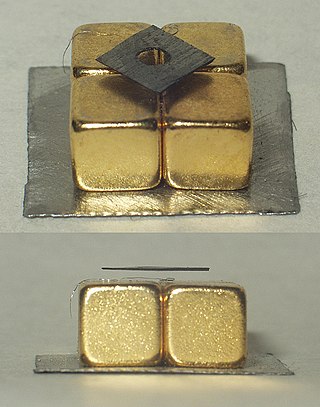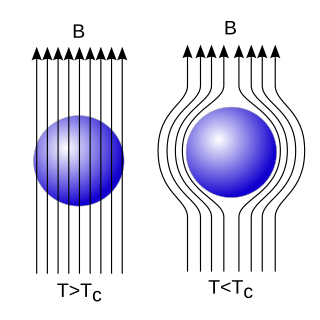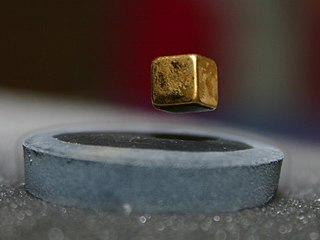
Diamagnetism is the property of materials that are repelled by a magnetic field; an applied magnetic field creates an induced magnetic field in them in the opposite direction, causing a repulsive force. In contrast, paramagnetic and ferromagnetic materials are attracted by a magnetic field. Diamagnetism is a quantum mechanical effect that occurs in all materials; when it is the only contribution to the magnetism, the material is called diamagnetic. In paramagnetic and ferromagnetic substances, the weak diamagnetic force is overcome by the attractive force of magnetic dipoles in the material. The magnetic permeability of diamagnetic materials is less than the permeability of vacuum, μ0. In most materials, diamagnetism is a weak effect which can be detected only by sensitive laboratory instruments, but a superconductor acts as a strong diamagnet because it entirely expels any magnetic field from its interior.

The Meissner effect is the expulsion of a magnetic field from a superconductor during its transition to the superconducting state when it is cooled below the critical temperature. This expulsion will repel a nearby magnet.

The triboelectric effect describes electric charge transfer between two objects when they contact or slide against each other. It can occur with different materials, such as the sole of a shoe on a carpet, or between two pieces of the same material. It is ubiquitous, and occurs with differing amounts of charge transfer (tribocharge) for all solid materials. There is evidence that tribocharging can occur between combinations of solids, liquids and gases, for instance liquid flowing in a solid tube or an aircraft flying through air.
In electromagnetism, the magnetic susceptibility is a measure of how much a material will become magnetized in an applied magnetic field. It is the ratio of magnetization M to the applied magnetizing field intensity H. This allows a simple classification, into two categories, of most materials' responses to an applied magnetic field: an alignment with the magnetic field, χ > 0, called paramagnetism, or an alignment against the field, χ < 0, called diamagnetism.

Levitation is the process by which an object is held aloft in a stable position, without mechanical support via any physical contact.
Plasma oscillations, also known as Langmuir waves, are rapid oscillations of the electron density in conducting media such as plasmas or metals in the ultraviolet region. The oscillations can be described as an instability in the dielectric function of a free electron gas. The frequency depends only weakly on the wavelength of the oscillation. The quasiparticle resulting from the quantization of these oscillations is the plasmon.

In physics, a "coffee ring" is a pattern left by a puddle of particle-laden liquid after it evaporates. The phenomenon is named for the characteristic ring-like deposit along the perimeter of a spill of coffee. It is also commonly seen after spilling red wine. The mechanism behind the formation of these and similar rings is known as the coffee ring effect or in some instances, the coffee stain effect, or simply ring stain.
The De Haas–Van Alphen effect, often abbreviated to DHVA, is a quantum mechanical effect in which the magnetic susceptibility of a pure metal crystal oscillates as the intensity of the magnetic field B is increased. It can be used to determine the Fermi surface of a material. Other quantities also oscillate, such as the electrical resistivity, specific heat, and sound attenuation and speed. It is named after Wander Johannes de Haas and his student Pieter M. van Alphen. The DHVA effect comes from the orbital motion of itinerant electrons in the material. An equivalent phenomenon at low magnetic fields is known as Landau diamagnetism.
Scanning probe lithography (SPL) describes a set of nanolithographic methods to pattern material on the nanoscale using scanning probes. It is a direct-write, mask-less approach which bypasses the diffraction limit and can reach resolutions below 10 nm. It is considered an alternative lithographic technology often used in academic and research environments. The term scanning probe lithography was coined after the first patterning experiments with scanning probe microscopes (SPM) in the late 1980s.

Nanofluidics is the study of the behavior, manipulation, and control of fluids that are confined to structures of nanometer characteristic dimensions. Fluids confined in these structures exhibit physical behaviors not observed in larger structures, such as those of micrometer dimensions and above, because the characteristic physical scaling lengths of the fluid, very closely coincide with the dimensions of the nanostructure itself.
A Ramsden emulsion, sometimes named Pickering emulsion, is an emulsion that is stabilized by solid particles which adsorb onto the interface between the water and oil phases. Typically, the emulsions are either water-in-oil or oil-in-water emulsions, but other more complex systems such as water-in-water, oil-in-oil, water-in-oil-in-water, and oil-in-water-in-oil also do exist. Pickering emulsions were named after S.U. Pickering, who described the phenomenon in 1907, although the effect was first recognized by Walter Ramsden in 1903.
Magnetolithography (ML) is a photoresist-less and photomaskless lithography method for patterning wafer surfaces. ML based on applying a magnetic field on the substrate using paramagnetic metal masks named "magnetic mask" placed on either topside or backside of the wafer. Magnetic masks are analogous to a photomask in photolithography, in that they define the spatial distribution and shape of the applied magnetic field. The fabrication of the magnetic masks involves the use of conventional photolithography and photoresist however. The second component of the process is ferromagnetic nanoparticles that are assembled over the substrate according to the field induced by the mask which blocks its areas from reach of etchants or depositing materials.
The distortion free energy density is a quantity that describes the increase in the free energy density of a liquid crystal caused by distortions from its uniformly aligned configuration. It also commonly goes by the name Frank free energy density named after Frederick Charles Frank.

Magnetic levitation (maglev) or magnetic suspension is a method by which an object is suspended with no support other than magnetic fields. Magnetic force is used to counteract the effects of the gravitational force and any other forces.

Edward Bormashenko is a professor of Materials Science and the Head of the Laboratory of Interface Science of the Ariel University in Israel. He was born in 1962 in Kharkiv, Ukraine and lives in Israel since 1997. He studied in the V. N. Karazin Kharkiv National University. His research is in the polymer science and surface science. He accomplished his PhD in Moscow Institute of Plastics in 1990.
Štefan Luby is a Slovak physicist and senior research fellow at the Slovak Academy of Sciences (SAS). He is doctor honoris causa of University of Salento, Italy, Slovak University of Technology in Bratislava, University of Constantine the Philosopher in Nitra, Slovakia, and Alexander Dubček University in Trenčín, Slovakia. He occupied positions of the director of the Institute of Physics of SAS for nine years and was the president of the SAS for fourteen years (1995–2009). He was the acting president of the All European Academies and the acting president of the Central European Academy of Sciences and Arts. At present, he is a member of Senate and vice-president of the European Academy of Sciences and Arts with the headquarters in Salzburg. He has chaired the editorial board of the Slovak Encyclopaedia Beliana since 1992.

Liquid marbles are non-stick droplets wrapped by micro- or nano-metrically scaled hydrophobic, colloidal particles ; representing a platform for a diversity of chemical and biological applications. Liquid marbles are also found naturally; aphids convert honeydew droplets into marbles. A variety of non-organic and organic liquids may be converted into liquid marbles. Liquid marbles demonstrate elastic properties and do not coalesce when bounced or pressed lightly. Liquid marbles demonstrate a potential as micro-reactors, micro-containers for growing micro-organisms and cells, micro-fluidics devices, and have even been used in unconventional computing. Liquid marbles remain stable on solid and liquid surfaces. Statics and dynamics of rolling and bouncing of liquid marbles were reported. Liquid marbles coated with poly-disperse and mono-disperse particles have been reported. Liquid marbles are not hermetically coated by solid particles but connected to the gaseous phase. Kinetics of the evaporation of liquid marbles has been investigated.

Droplet cluster is a self-assembled levitating monolayer of microdroplets usually arranged into a hexagonally ordered structure over a locally heated thin layer of water. The droplet cluster is typologically similar to colloidal crystals. The phenomenon was observed for the first time in 2004, and it has been extensively studied after that.
Self-propulsion is the autonomous displacement of nano-, micro- and macroscopic natural and artificial objects, containing their own means of motion. Self-propulsion is driven mainly by interfacial phenomena. Various mechanisms of self-propelling have been introduced and investigated, which exploited phoretic effects, gradient surfaces, breaking the wetting symmetry of a droplet on a surface, the Leidenfrost effect, the self-generated hydrodynamic and chemical fields originating from the geometrical confinements, and soluto- and thermo-capillary Marangoni flows. Self-propelled system demonstrate a potential as micro-fluidics devices and micro-mixers. Self-propelled liquid marbles have been demonstrated.
Interfacial rheology is a branch of rheology that studies the flow of matter at the interface between a gas and a liquid or at the interface between two immiscible liquids. The measurement is done while having surfactants, nanoparticles or other surface active compounds present at the interface. Unlike in bulk rheology, the deformation of the bulk phase is not of interest in interfacial rheology and its effect is aimed to be minimized. Instead, the flow of the surface active compounds is of interest..











